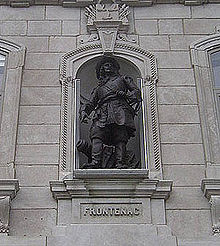Comte de Frontenac
| Louis de Buade de Frontenac | |
|---|---|

Statue of Frontenac at the National Assembly of Quebec (Assemblée nationale du Québec)
|
|
| 3rd and 6th Governor General of New France | |
|
In office 1672–1682 |
|
| Monarch | Louis XIV |
| Deputy | none (1672-1675) Jacques Duchesneau de la Doussinière et d'Ambault(1675-1682) |
| Preceded by | Daniel de Rémy de Courcelle |
| Succeeded by | Joseph-Antoine Le Febvre de La Barre |
|
In office 1689–1698 |
|
| Monarch | Louis XIV |
| Deputy | Jean Bochart de Champigny |
| Preceded by | Jacques-René de Brisay de Denonville, Marquis de Denonville |
| Succeeded by | Louis-Hector de Callière |
| Personal details | |
| Born | May 22, 1622 Saint-Germain-en-Laye, France |
| Died | November 28, 1698 (aged 76) Chateau St-Louis, Quebec City, New France, French colonial empire |
| Signature | |
Louis de Buade, Comte de Frontenac et de Palluau (French pronunciation: [lwi də bɥad kɔ̃t də fʁɔ̃tənak e də palɥo]; May 22, 1622 – November 28, 1698) was a French soldier, courtier, and Governor General of New France from 1672 to 1682 and from 1689 to his death in 1698. He established a number of forts on the Great Lakes and engaged in a series of battles against the English and the Iroquois.
In his first term, he supported the expansion of the fur trade, establishing Fort Frontenac (in what is now Kingston, Ontario) and came into conflict with the other members of the Sovereign Council over its expansion and over the corvées required to build the new forts. In particular, despite the opposition of bishop François de Laval, he supported selling brandy to the Aboriginal tribes, which Laval considered a mortal sin. The conflict with the Sovereign Council led to his recall in 1682.
His second term was characterised by the defence of Quebec from a British invasion during King William's War, a successful guerrilla campaign against the Iroquois and English settlements which resulted in the elimination of the Iroquois threat against New France, and a large expansion of the fur trade using Canadian coureurs des bois. He died before his second recall to France.
Frontenac was born in Saint-Germain-en-Laye, the son of Henri de Buade, colonel in the regiment of Navarre, and Anne Phélypeaux, daughter of Raymond Phélypeaux. The details of his early life are meager, as no trace of the Frontenac papers have been discovered. The de Buades, however, were a family of distinction in the principality of Bearn. Antoine de Buade, seigneur de Frontenac, grandfather of the future governor of Canada, attained eminence as a councilor of state under Henri IV; and his children were brought up with the dauphin, afterwards Louis XIII.
...
Wikipedia
